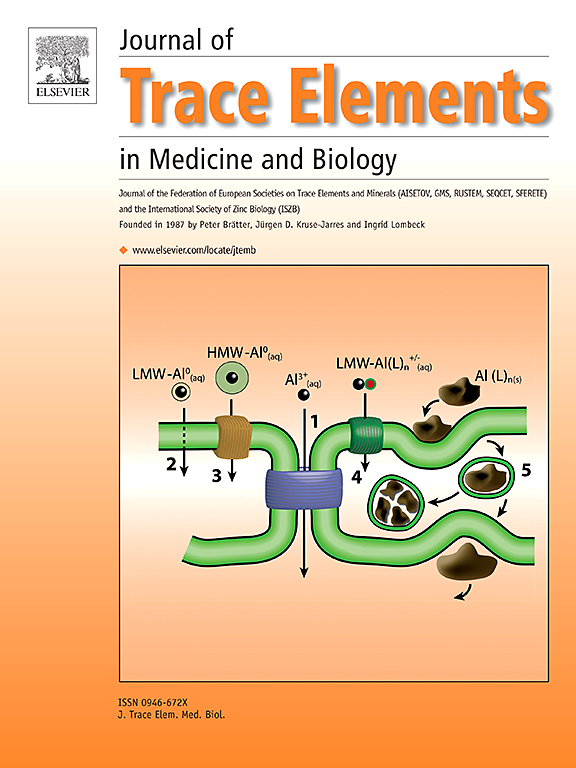Elemental mapping of cocoa beans with laser-induced breakdown spectroscopy
IF 3.6
3区 医学
Q2 BIOCHEMISTRY & MOLECULAR BIOLOGY
Journal of Trace Elements in Medicine and Biology
Pub Date : 2025-06-26
DOI:10.1016/j.jtemb.2025.127690
引用次数: 0
Abstract
Cocoa and chocolate are important trading goods and serve as a source of minerals and essential trace elements, important in the human diet. The standard industry practice for quantifying elements in cocoa samples involves the use of inductively coupled plasma mass spectrometry and atomic absorption spectrometry. Within an experimental lab environment, X-ray fluorescence with micrometer resolution (µXRF) can reveal the spatial distribution of elements across cocoa beans. Over the past years, laser-induced breakdown spectroscopy (LIBS) has become an emerging analytical technique for a wide range of applications. Imaging cocoa beans with LIBS is challenging because it exhibits areas with low and high density (shell vs inner structure) and the inner structure has a very low melting point. To minimize melting and ensure an optimal lateral resolution for LIBS imaging, a thorough assessment of the experimental parameters and data preprocessing is necessary. This study reveals the capabilities and limitations of LIBS for mapping mineral and trace element distribution in cocoa beans within only 90 min. A carbon-based normalization method was adopted to rectify the experimental variations resulting from sample ablation initiated by the laser beam, thus allowing for reliable sample comparisons. A side-by-side comparison of µXRF and LIBS data from the same cocoa beans shows that both techniques yield similar elemental images, although LIBS displays somewhat lower resolution. Furthermore, detailed images of five individual cocoa beans are examined to illustrate how LIBS effectively detects variations in elemental distributions. The advantages of multi-element analysis, fast response, little to no sample preparation and ease of use position LIBS alongside µXRF as a promising technique for the cocoa sector.
用激光诱导击穿光谱法绘制可可豆元素图
可可和巧克力是重要的贸易商品,是矿物质和必需微量元素的来源,在人类饮食中很重要。定量可可样品中元素的标准工业实践包括使用电感耦合等离子体质谱法和原子吸收光谱法。在实验实验室环境中,微米分辨率的x射线荧光(µXRF)可以揭示可可豆中元素的空间分布。在过去的几年里,激光诱导击穿光谱(LIBS)已经成为一种新兴的分析技术,具有广泛的应用。用LIBS对可可豆进行成像是具有挑战性的,因为它显示出高密度和低密度(壳与内部结构)的区域,而内部结构的熔点非常低。为了最大限度地减少熔化并确保LIBS成像的最佳横向分辨率,有必要对实验参数和数据预处理进行全面评估。这项研究揭示了LIBS在90 min内绘制可可豆中矿物质和微量元素分布的能力和局限性。采用碳基归一化方法来纠正由激光束引起的样品烧蚀引起的实验变化,从而允许可靠的样品比较。µXRF和LIBS数据的并排比较表明,两种技术产生相似的元素图像,尽管LIBS显示的分辨率稍低。此外,五个单独的可可豆的详细图像进行了检查,以说明LIBS如何有效地检测元素分布的变化。多元素分析、快速响应、几乎不需要样品制备和易于使用的优点使LIBS与µXRF一起成为可可行业的一种有前途的技术。
本文章由计算机程序翻译,如有差异,请以英文原文为准。
求助全文
约1分钟内获得全文
求助全文
来源期刊
CiteScore
6.60
自引率
2.90%
发文量
202
审稿时长
85 days
期刊介绍:
The journal provides the reader with a thorough description of theoretical and applied aspects of trace elements in medicine and biology and is devoted to the advancement of scientific knowledge about trace elements and trace element species. Trace elements play essential roles in the maintenance of physiological processes. During the last decades there has been a great deal of scientific investigation about the function and binding of trace elements. The Journal of Trace Elements in Medicine and Biology focuses on the description and dissemination of scientific results concerning the role of trace elements with respect to their mode of action in health and disease and nutritional importance. Progress in the knowledge of the biological role of trace elements depends, however, on advances in trace elements chemistry. Thus the Journal of Trace Elements in Medicine and Biology will include only those papers that base their results on proven analytical methods.
Also, we only publish those articles in which the quality assurance regarding the execution of experiments and achievement of results is guaranteed.

 求助内容:
求助内容: 应助结果提醒方式:
应助结果提醒方式:


